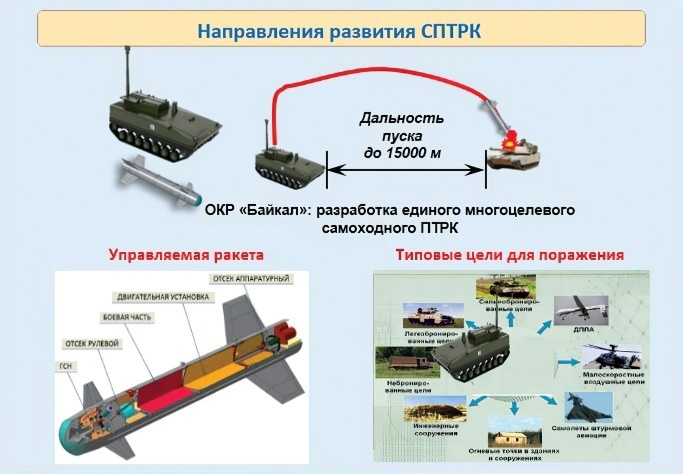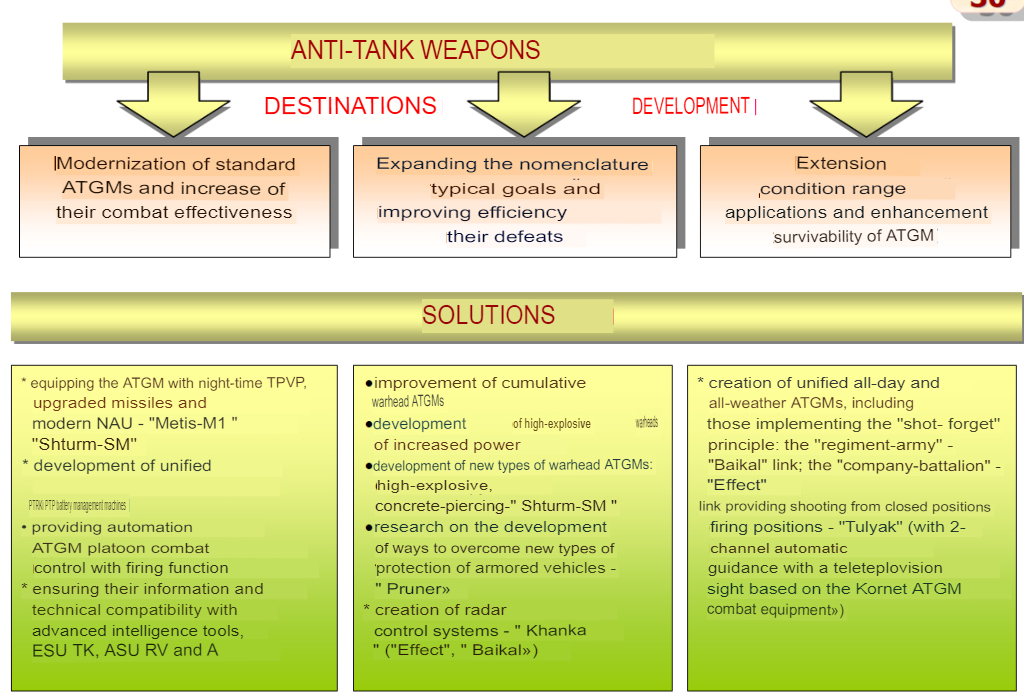Think of an APFSDS projectile, but being self propelled and guided instead of having to be fired from a gun.
Yep... has been proposed before...
The Hermes was going to be one such missile... essentially a long thin missile with a long solid rocket booster to accelerate it to speed... instead of a 30kg HE warhead a 30kg 30mm diameter core of DU that is 2-3m long that has steering and command guidance... the enlarged solid rocket booster accelerates the missile to 2km/s at 1.5km from the launcher and then burns out and falls away... the remaining front section of the missile is small because it is dense and heavy but not heavier than the original missile... 30kgs of DU takes up much less space than 30kgs of HE with a shaped charge warhead which requires and empty hollow metal lined section.
A 30kg DU rod travelling at over 1.5km/s out to say 8km would be devastating... the 125mm APFSDS round moves at 1.8km/s but is only 7kgs.
The problem is efficiency... the propellent needed to launch that missile is probably 100kg of solid rocket fuel... which is about 5 times more than the propellent used in the 125mm gun.
I believe that in the near future the concept of the missile tank with kinetic energy missiles will be useful, because tanks are becoming ever more expensive, less numerous and more sophisticated just like combat aircraft, so you need more expensive and deadlier, if fewer munitions to destroy them.
The other reason is simply that chemical propellants are at their technological limit and railguns and electrothermal guns are fantasy. Only missiles can accelerate above 2000 m/s while being compact and efficient. Increasing gun calibre could improve APFSDS performance but thats unsustainable too.
Scramjet propulsion opens the door to higher speeds than solid rockets can practically attain... the Zircon missile moves at 3.2km/s for instance.
The newest model Hermes missiles will have scramjet motors in their second stages so after being accelerated to 1.3km per second at 1.5km range the solid rocket booster falls away and the main scramjet engine could light up and actually accelerate the next stage of the missile to faster and faster speeds... obviously a low altitude your top speed would be limited, but climb very high and dive on the target and gravity can assist in getting to higher impact speeds on target... with the added bonus of a top attack weapon hitting the thinner armour.
Ironically hitting at a diving speed of 3km/s you wouldn't need a long rod penetrator... a 5kg lump of mild steel with a sort of a point at the front that spreads out to maybe a chunk with a 6cm radius and maybe 20-30cm long would be devastating to the top armour of any tank without having to waste money on expensive or exotic expensive metals like DU or Tungsten...
A related concept to a kinetic energy ATGM is a ramjet powered APFSDS round, and AFAIK russia has black projects to design one for its 152mm tank guns. Now imagine the ramjet powered APFSDS to be guided. And have a range of 4+km. And have a RHA penetration of 3000mm+.
The Pine or SOSNA missile is a two stage tube launched weapon with anti aircraft and anti armour roles... in its current form its solid rocket booster accelerates it up to about 1.4km/s and then it coasts to the target... with an 8-12 second flight time to targets 10km away.
They are upgrading it to extend its range to 20km AFAIK... so perhaps some form of ramjet sustainer to maintain speed to target and of course laser beam riding guidance.
The IT-1 was actually ahead of its time, because it was born in a time where tanks were relatively simple and mass produced. Currently precision matters in HE strikes too, so a missile tank can have a stash of HE or thermobaric ATGMs too.
The IT-1 was interesting... the US equivalent was essentially the Sheridan and M60A2, but it was found that much cheaper simpler lighter vehicles... the MTLB in the Soviet army, and the M113 in the US Army could carry cheaper slower and less effective missiles, but as the US missile was bloody awful and never worked despite being taken into combat multiple times, they ended up realising a missile tank is silly.
What the Soviets realised is that long range shooting accuracy only makes sense if the target remains still, or you can correct your aim after you fired the round. A tank gun fired missile meant a moving target could be hit at very long range which is something even the most accurate western tank gun cannot achieve with standard unguided tank rounds.
Instead of a missile firing super tank the Soviets managed to improve the capacities of all their tanks from the T-55 right through to the best and most expensive tanks. The missiles could also be fired from other vehicles with large calibre guns including artillery... and they gave their armour some capacity against helicopters and aircraft too.
The upgrades to the tanks to allow missiles to be fired also added better optics and laser range finders to otherwise older obsolete vehicles.
Launch signature wouldnt matter when you have a missile coming at 1600-3000 m/s. By that logic the smoke blast of a conventional tank cannon is a fatal flaw.
The amount of solid rocket fuel needed to get a missile to such speeds already makes the system not man portable, and also very expensive potentially.
Guns use propellent rather more efficiently than rockets do.... experience around the world is for systems to use both.
The difference between a tank gun muzzle flash that might be 6-8 metres long and 4-5 metres wide is nothing compared with the rather larger rocket plume from a solid rocket booster accelerating a Hermes like missile to over 1km/s.
The solid rocket booster on the Hermes with a 20km range has a burn range of about 1.2 to 1.5km, so that big bright burning column of fire accelerating about 1.5km across the battlefield is going to be a bit more obvious than an instantaneous flash of a tank gun firing to be fair.
Anyway Russia is on the right track with the hermes. if they manage to make a variant with a tungsten rod on its second stage, it could be a deadly direct fire kinetic energy tank killer.
The thing is that the Hermes is a multi use system intended to be used against a wide variety of targets, so some sort of combination HE Frag and HEAT warhead is actually rather more likely most of the time.
Youre implicitly calling the military planners of virtually all countries armies retards for adopting ATGMs that outrange tank guns then.
I am not calling anyone retarded.
ATGMs outranging tank guns means nothing if the tank remains in dead ground as it approaches your position and then proceeds to machine gun your position.
Plus the little factor of an infantry or vehicle based ATGM like an M113 based TOW vehicle or something similar can be engaged out to about 12km with the 125mm gun and HE Frag rounds.
I ask again, what is a tank crew gonna do to with a 1600m/s missile approaching them? You assume they'll be able to fire back?
If the tank is an Armata then the APS will detect the incoming threat and intercept it 10-20m from the tank causing the penetrator to yaw and become ineffective while alerting the crew to the attack and turning the main gun towards the location the incoming round seemed to come from... which is probably the first step in destroying the platform that launched the attack in the first place.
The incoming projectiles trajectory can be logged and passed to all nearby friendly forces to warn them of the threat too and they can all start scanning for ground or air sources of such weapon types to engage.
Any available airborne drones will be directed to look in that direction too.
Hermes is going to come out of the box with top-attack capability. I've yet to see a tank with roof armor that can resist getting caved in with a direct 152 mm shell, and Hermes is even more massive.
The warhead on the current model is a 30kg dual purpose HEAT warhead with fragmentation capacity and smart fuse for different targets.
The proposed future Hermes with 100km range and powered second stage able to manouver to evade enemy air defences is reportedly going to have double the HE payload of about 58kgs of HE... which might be a tandem warhead of course...






 lyle6
lyle6